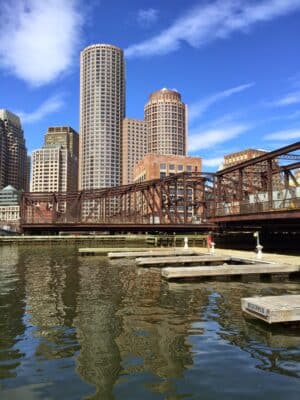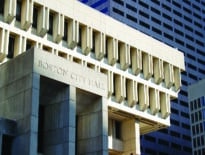
A conceptual resilience plan commissioned by the Wharf District Council envisions a 1.5-mile flood barrier protecting the downtown Boston waterfront from sea level rise. Photo by Steve Adams | Banker & Tradesman Staff
Around Boston Harbor, talk about sea level rise and future flooding has moved from hypotheticals about future storms to detailed projections, official design guidance and the lived experience from 2018’s winter storms. No one pursuing waterfront development can ignore the increased flood risks and other climate threats anticipated in the years and decades to come.
The Boston Planning & Development Agency’s Coastal Flood Resilience Design Guidelines from 2019, as well as the subsequent zoning overlay released in 2021, have created clearer roadmaps for mitigating risks to buildings that might be subject to inundation. Meanwhile, Boston’s Environment Department has published Coastal Adaptation Plans with visions for creating connected flood protection systems for whole districts.
All of this is great progress relative to a decade ago when climate planning was just beginning at the city; however, very few visionary climate adaptation projects have yet been realized.
Nature-Based Benefits
Boston Harbor Now uses a framework called Harborwalk 2.0 to describe our aspirations for a waterfront that is accessible and welcoming, prepared for the coastal impacts of climate change and centers equity and inclusion in its design, construction and programming. We advocate for coastal adaptation projects and push projects to connect across property boundaries and incorporate nature-based approaches – strategies that mimic or recreate natural systems in lieu of relying exclusively on “gray” or “hard” infrastructure.
Nature-based approaches include a range of shorelines from living seawalls to oyster reefs to “cobble berms” (carefully placed rock piles) to “vegetated berms” (long hills planted with grasses or shrubs). Unlike traditional infrastructure, nature-based approaches can provide multiple benefits: improved water and air quality, increased habitat and ecosystem diversity, expanded recreational spaces and positive economic ripple effects from attracting more people to the waterfront as well as the jobs that come from building and monitoring them. Nature-based solutions are almost always more aesthetically pleasing and welcoming than “gray” solutions.
Two local projects that have created new living shorelines are Clippership in East Boston and the Encore Casino in Everett. Both overcame significant permitting hurdles to create new wetland habitats and had to scale back their initial designs considerably. Elsewhere coastal resilience projects that would build into the water are being forced by regulatory hurdles to scale back their ideas, like The Trustees of Reservations’ Piers Park III proposal where the original proposal provided more extensive shoreline restoration, or are being postponed for later phases, like the city’s design for preventing flooding at Lewis Mall.

Kathy Abbott
Deterrent to Downtown Flooding
Recently, the Wharf District Council, composed of residents and businesses on Boston’s downtown waterfront, released a conceptual climate resilience plan that incorporates a combination of different strategies for addressing coastal flooding, including nature-based approaches at some sites. The plan extends across multiple property boundaries to effectively block flood waters from extending into the district and vulnerable areas behind it, including the Rose Kennedy Greenway and Faneuil Hall Marketplace/Quincy Market. While we agree it is a bold community generated planning effort, permitting challenges loom for its implementation.
State legislators recognize that the permitting hurdles are one major challenge facing bold projects, which is why Rep. Dan Hunt and Sen. Brendan Creighton have filed legislation to support regulatory flexibility for research and demonstration projects that can model the effectiveness of nature-based approaches, and pave the way for additional changes to incorporate climate change preparedness into more state processes.

Alice Brown
As this summer’s shocking weather events remind us, as well as the near-catastrophe Boston narrowly avoided in 2012 when a Superstorm Sandy landing just six hours earlier or later at high tide would have sent harbor flood waters all the way up State Street: We need to keep moving the ball forward as we anticipate and address the impacts of worsening climate change.
Now is the time to reimagine more boldly the Boston shoreline as a place that provides ecological, social and economic benefits fully integrated with strong flood protection. By mimicking natural systems and creating more connected and inclusive public spaces along the Harborwalk, the city can offer coastal and community resilience – and an even more beautiful Boston – for generations to come.
Kathy Abbott is president and CEO and Alice Brown is chief of policy and planning at Boston Harbor Now.






